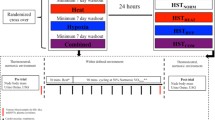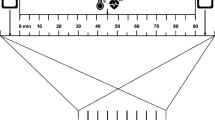Abstract
Heat shock proteins (HSPs) work in response to a variety of external and internal stresses to maintain homeostasis and are upregulated upon cellular damage. This study aimed to determine the effect of maximal aerobic effort test (\({{\dot {V}}}{{{\text{O}}}_{2}}\)max test) on the expression of genes related to heat shock proteins’ (HSPs) cycle (HSP90AA1, HSP90AB1, PTGES3). Eleven black-belt taekwondo male athletes participated in this study and performed a \({{\dot {V}}}{{{\text{O}}}_{2}}\)max test on a treadmill connected to the Cortex gas analyzer till the point of physical exhaustion. Gene expression was analyzed by real-time PCR, while the physiological parameters were measured spectrophotometrically or by immune assays using serum form the blood Before the test (Bf), Immediately After (IA), and Two Hours After (2HA) the \({{\dot {V}}}{{{\text{O}}}_{2}}\)max test. The levels of fold change expression were affected by the VO2max test. HSP90AA1, HSP90AB1 and PTGES3 mRNA levels were significantly higher IA the test (P ≤ 0.05). HSPs surpassed the cut-off value (1.5-fold) IA showed (M = 2.29 times for HSP90AA1), (M = 1.68 times for HSP90AB1), while PTGES3 did not reach the cut-off value (M = 1.12 times). The expression levels of the three genes were significantly decreased 2HA and returned to the baseline values. Moreover, physiological parameters including growth hormone, creatinine kinase, white blood cells, platelets count, and blood lactate showed a peak in their levels IA the test and then dropped 2HA (P ≤ 0.05). Our findings demonstrate that genetic expressions of HSP90AA1 and HSP90AB1 genes were significantly elevated IA the test and decreased 2HA. The same applied on most of the physiological parameters; strongly suggesting the possible utility of using those parameters as a reference to confirm evidence of exercise-induced cell stress.

Similar content being viewed by others
REFERENCES
Fulda, S., Gorman, A.M., Hori, O., and Samali, A., Cellular stress responses: cell survival and cell death, Int. J. Cell Biol., 2010, vol. 2010, p. 1.
Fittipaldi, S., Dimauro, I., Mercatelli, N., and Caporossi, D., Role of exercise-induced reactive oxygen species in the modulation of heat shock protein response, Free Radical Res., 2014, vol. 48, no. 1, p. 52.
Cuthbert, R., Human skeletal muscle response to exercise in differing environmental temperatures, MSc Thesis, Omaha, NE: Univ. of Nebraska Omaha, 2018. https://www.proquest.com/openview/be62978d8721-072c07f1c22243609846/1?pq-origsite=gscholar&cbl= 18750&diss=y
Madden, L.A., Sandström, M.E., Lovell, R.J., and McNaughton, L., Inducible heat shock protein 70 and its role in preconditioning and exercise, Amino Acids, 2008, vol. 34, no. 4, p. 511.
Nussbaum, R., McInnes, R.R., and Willard, H.F., Thompson & Thompson Genetics in Medicine, Philadelphia, PA: Elsevier, 2016, 8th ed.
Li, J., Richter, K., and Buchner, J., Mixed Hsp90-cochaperone complexes are important for the progression of the reaction cycle, Nat. Struct. Mol. Biol., 2011, vol. 18, no. 1, p. 61.
Friday, A.E., Kester, D., and Joy, E.I., Heat shock protein 90 alpha genes are up-regulated by acute exercise, Adv. Biochem., 2017, vol. 5, no. 4, p. 57.
Maltseva, D.V., Ryabenko, E.A., Sizova, S.V., et al., Effect of exercise on the expression of HSPBP1, PGLYRP1, and HSPA1A genes in human leukocytes, Bull. Exp. Biol. Med., 2012, vol. 153, no. 6, p. 867.
Valko, M., Leibfritz, D., Moncol, J., et al., Free radicals and antioxidants in normal physiological functions and human disease, Int. J. Biochem. Cell Biol., 2007, vol. 39, no. 1, p. 44.
Wilmore, J.H. and Costill D. L., Physiology of Sport and Exercise, Champaign, IL: Human Kinetics, 1994.
Finsterer, J., Biomarkers of peripheral muscle fatigue during exercise, BMC Musculoskeletal Disord., 2012, vol. 13, no. 1, p. 218.
Koolhaas, J.M., Bartolomucci, A., Buwalda, B., et al., Stress revisited: A critical evaluation of the stress concept, Neurosci. Biobehav. Rev., 2011, vol. 35, no. 5, p. 1291.
Blagrove, R.C., Howatson, G., and Hayes, P.R., Effects of strength training on the physiological determinants of middle-and long-distance running performance: a systematic review, Sports Med., 2018, vol. 48, no. 5, p. 1117.
Nam, S.-S. and Lim, K., Effects of Taekwondo training on physical fitness factors in Korean elementary students: A systematic review and meta-analysis, J. Exercise Nutr. Biochem., 2019, vol. 23, no. 1, p. 36.
Toraih, E.A., Alrefai, H.G., Hussein, M.H., et al., Overexpression of heat shock protein HSP90AA1 and translocase of the outer mitochondrial membrane TOM34 in HCV-induced hepatocellular carcinoma: a pilot study, Clin. Biochem., 2019, vol. 63, p. 10.
Noble, E.G., Milne, K.J., and Melling, C.W.J., Heat shock proteins and exercise: a primer, Appl. Physiol. Nutr. Metab., 2008, vol. 33, no. 5, p. 1050.
Csermely, P., Schnaider, T., Soti, C., et al., The 90‑kDa molecular chaperone family: Structure, function, and clinical applications. A comprehensive review, Pharmacol. Ther., 1998, vol. 79, no. 2, p. 129.
Zininga, T., Ramatsui, L., and Shonhai, A., Heat shock proteins as immunomodulants, Molecules, 2018, vol. 23, no. 11, p. 2846.
Li, J., Soroka, J., and Buchner, J., The Hsp90 chaperone machinery: conformational dynamics and regulation by co-chaperones, Biochim. Biophys. Acta, Mol. Cell Res., 2012, vol. 1823, no. 3, p. 624.
Schopf, F.H., Biebl, M.M., and Buchner, J., The HSP90 chaperone machinery, Nat. Rev. Mol. Cell Biol., 2017, vol. 18, no. 6, p. 345.
Périard, J.D., Ruell, P., Caillaud, C., and Thompson, M.W., Plasma Hsp72 (HSPA1A) and Hsp27 (HSPB1) expression under heat stress: influence of exercise intensity, Cell Stress Chaperones, 2012, vol. 17, no. 3, p. 375.
Maltseva, D.V., Ryabenko, E.A., Sizova, S.V., et al., Effect of exercise on the expression of HSPBP1, PGLYRP1, and HSPA1A genes in human leukocytes, Bull. Exp. Biol. Med., 2012, vol. 153, no. 6, p. 867.
Fedosov, D.A. and Gompper, G., White blood cell margination in microcirculation, Soft Matter, 2014, vol. 10, no. 17, p. 2961.
Wells, C.L., Stern, J.R., and Hecht, L.H., Hematological changes following a marathon race in male and female runners, Eur. J. Appl. Physiol. Occup. Physiol., 1982, vol. 48, no. 1, p. 41.
Sakharov, D.A., Maltseva, D.V., Riabenko, E.A., et al., Passing the anaerobic threshold is associated with substantial changes in the gene expression profile in white blood cells, Eur. J. Appl. Physiol., 2012, vol. 112, no. 3, p. 963.
El-Sayed, M., Effects of exercise on blood coagulation, fibrinolysis and platelet aggregation, Sports Med., 1996, vol. 22, no. 5, p. 282.
Bourey, R.E. and Santoro, S.A., Interactions of exercise, coagulation, platelets, and fibrinolysis-a brief review, Med. Sci. Sports Exercise, 1988, vol. 20, no. 5, p. 439.
Wang, J.S., Jen, C.J., Kung, H.C., et al., Different effects of strenuous exercise and moderate exercise on platelet function in men, Circulation, 1994, vol. 90, no. 6, p. 2877.
Hoppel, F., Calabria, E., Pesta, D.H., et al., Effects of ultramarathon running on mitochondrial function of platelets and oxidative stress parameters: a pilot study, Front. Physiol., 2021, vol. 12, p. 632664.
van Beaumont, W., Red cell volume with changes in plasma osmolarity during maximal exercise, J. Appl. Physiol., 1973, vol. 35, no. 1, p. 47.
van Beaumont, W., Strand, J.C., Petrofsky, J.S., et al., Changes in total plasma content of electrolytes and proteins with maximal exercise, J. Appl. Physiol., 1973, vol. 34, no. 1, p. 102.
Kratz, A., Lewandrowski, K.B., Siegel, A.J., et al., Effect of marathon running on hematologic and biochemical laboratory parameters, including cardiac markers, Am. J. Clin Pathol., 2002, vol. 118, no. 6, p. 856.
Beneke, R., Leithäuser, R.M., and Ochentel, O., Blood lactate diagnostics in exercise testing and training, Int. J. Sports Physiol. Perform., 2011, vol. 6, no. 1, p. 8.
Melkonian, E.A. and Schury, M.P., Biochemistry, Anaerobic Glycolysis, Treasure Island, FL: StatPearls, 2019.
Sakharov, D.A., Stepanov, A.V., Shkurnikov, M.Yu., and Tonevitskii, A.G., Short-term highly intense physiological stress causes an increase in the expression of heat shock protein in human leukocytes, Bull. Exp. Biol. Med., 2009, vol. 147, no. 3, p. 361.
Yoon, S.J., Lee, M.J., Lee, H.M., and Lee, J.S., Effect of low-intensity resistance training with heat stress on the HSP72, anabolic hormones, muscle size, and strength in elderly women, Aging Clin. Exp. Res., 2017, vol. 29, no. 5, p. 977.
Wideman, L., Weltman, J.Y., Hartman, M.L., et al., Growth hormone release during acute and chronic aerobic and resistance exercise: recent findings, Sports Med., 2002, vol. 32, no. 15, p. 987.
Kanda, K., Sugama, K., Sakuma, J., et al., Evaluation of serum leaking enzymes and investigation into new biomarkers for exercise-induced muscle damage, Exercise Immunol. Rev., 2014, vol. 20, p. 39.
Hazar, M., Otag, A., Otag, I., et al., Effect of increasing maximal aerobic exercise on serum muscles enzymes in professional field hockey players, Global J. Health Sci., 2015, vol. 7, no. 3, p. 69.
Koury, J.C., Daleprane, J.B., Pitaluga-Filho, M.V., et al., Aerobic conditioning might protect against liver and muscle injury caused by short-term military training, J. Strength Cond. Res., 2016, vol. 30, no. 2, p. 454.
Nie, J., Tong, T.K., George, K., et al., Resting and post-exercise serum biomarkers of cardiac and skeletal muscle damage in adolescent runners, Scand. J. Med. Sci. Sports, 2011, vol. 21, no. 5, p. 625.
ACKNOWLEDGMENTS
Authors would like to express their thankfulness to the athletes who participated in the present study.
Funding
This research was funded by a grant from the University of Jordan (Grant number: 30 049, 2018/2019). The authors report no involvement in the research by the sponsor that could have influenced the outcome of this work.
Author information
Authors and Affiliations
Corresponding author
Ethics declarations
COMPLIANCE WITH ETHICAL STANDARDS
This study was approved by the Faculty of Graduate Studies in the University of Jordan. Ethical approval was obtained from the Research Ethics Committee (no. 4970 2018−2019). The objective of the study was explained to all participants and a consent form was signed by all the subjects who agreed to participate. All the work was conducted according to the principles of good clinical practice that have their origin in the declaration of Helsinki and good laboratory practice for the analysis of blood samples.
CONFLICTS OF INTERESTS
The authors declare that they have no competing interests with no conflict of interests with any financial organization regarding the material discussed in the manuscript.
Rights and permissions
About this article
Cite this article
Hammad, R., Srour, L., Hammad, S. et al. Maximal Aerobic Effort Increases Genetic Expression of HSP90AA1, HSP90AB1, and PTGES3 in Elite Taekwondo Athletes. Hum Physiol 48, 254–260 (2022). https://doi.org/10.1134/S0362119722030070
Received:
Revised:
Accepted:
Published:
Issue Date:
DOI: https://doi.org/10.1134/S0362119722030070




